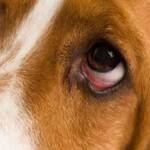The lacrimal glands in companion animal eyes produce a lubricating tear film that moistens and protects the eyes. When this tear film is reduced or absent, the surface of the eye can become dry, irritated and even crack leading to painful ulcerations.
Tears also contain anti-bacterial proteins and salts and serve to flush away the irritants and infectious agents that are constantly getting in our eyes.
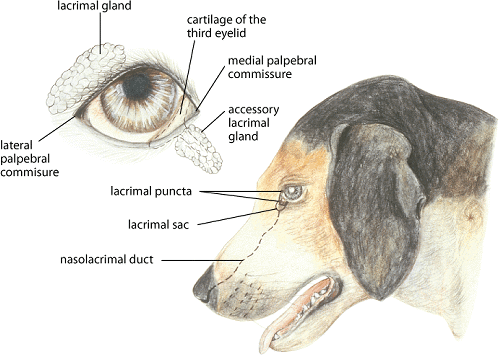
Tears are comprised of water, oil and mucus secreted by their respective eyelid glands. The water portion of tears is secreted by two lacrimal glands in dogs and cats: one just above the eye and another in the third eyelid (or so-called nictitating membrane).
Keratoconjunctivitis sicca is a fancy way of saying the eye is dry. “Kerato” refers to the cornea or clear covering of the eye that faces the outside world. “Conjunctivae” are the moist pink membranes of the eye socket. “Itis” means inflammation and “sicca” means dry.
Keratoconjunctivitis sicca, abbreviated KCS, means there is an inflamed, dry cornea and conjunctiva. This happens when the glands of the eye have reduced to no production of the water portion of the tears, which normally accounts for 95% of the tear volume.
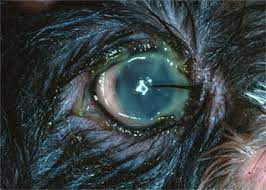
In the absence of water, an individual is left with oil and mucus, which results in the gooey eye discharge that is classic for this condition.
As a result of drying, the eyes become irritated, the conjunctival tissues get red, the cornea itself in time will turn brown in an effort to protect the eye, ulceration can occur and after prolonged ulcers and pigmentation, blindness can result.
Why does KCS occur?
There are many reasons, including:
The most common cause of KCS is immune-mediated destruction of the tear-producing gland tissue. Breeds such as the American Cocker Spaniel, the Miniature Schnauzer, and the West Highland white terrier are pre-disposed
Other causes:
- Canine distemper infection attacks all body interfaces with the environment including the eyes. Dry eye is part of the constellation of symptoms that can occur with canine distemper infection.
- In cats, herpes upper respiratory infection can lead to a chronic dry eye (see more on herpes conjunctivitis).
- There could be a congenital lack of tear-producing gland tissue (as described in certain lines of Yorkshire terrier).
- Exposure to sulfa-containing antibiotics, such as trimethoprim-sulfa combinations, can lead to dry eye. It can be either temporary or permanent and occurs unpredictably.
- Anesthesia will reduce tear function temporarily (thus eyes are lubricated with ointment by the attending nurse).
- During surgery for cherry eye, removal of the third eyelid tear-producing gland, instead of replacing the gland in its proper location, can lead to KCS. So can too much damage to the gland prior to proper gland replacement.
- A knock on the head in the area of one of the tear-producing glands can lead to KCS.
How we Make the Diagnosis
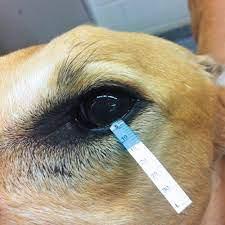
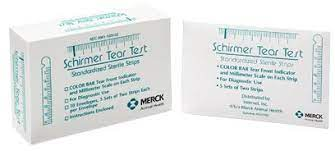
To diagnose KCS, we use paper strips in the eyelids that measure tear production. The strip is placed in each eye for 60 seconds. A length of 15mm or more of moistened area (the blue in the above picture) is normal. A height of less than 10mm is dry. A height less than 5mm is severely dry.
How do we Treat this Condition?
Cyclosporineis an immuno-suppressive agent. There is a topical eye ointment and/or drop available for treating conditions like KCS at the specific site. When applied to the eye, it suppresses the immune destruction of the glands and helps restore tear production
This treatment works well in most cases usually with the application every 12 hours. In severe cases or early on, 3X daily may be used.
Optimmune® eye ointment (containing 0.2% cyclosporine) is a brand of cyclosporine commonly used. Occasionally, patients simply do not show a good response to cyclosporine ointment but will respond when the concentration is increased to 0.3%.
Higher concentration products can easily be formulated by compounding pharmacies. If the increased concentration doesn’t work, a more potent eye drop called Tacrilimus may be used.
After beginning cyclosporine eye drops or ointment, a recheck in three to four weeks is generally recommended to ensure tear production has improved.
Periodic rechecks are needed for dose adjustment and some dogs take as long as three to four months to show a response. Dogs with Schirmer tear tests as low as 2 mm still have an 80 percent chance of responding to cyclosporine. This medication has been a miraculous breakthrough in the treatment of KCS.
Other treatments:
Pilocarpine is an oral medication that can be used if your companion animal is not responding well to topical eye medication. While the medication is in an eye drop form, it is given orally and the amount increased as needed until results are seen.
Artificial tear solutions, gels and ointments can be purchased in most drug stores. These drugs can help keep the eyes moist in between cyclosporine or tacrilimus. They are combined with other therapies and are soothing. Their use is particularly important early in therapy until cyclosporine or tacrolimus take effect and in eyes that do not respond to these latter medications.
Topical antibiotics are often needed, especially when starting treatment for KCS because secondary infections are common with inadequate tears. These products do not increase tear production but help lubricate the eyes and combat infection.
Surgical Solutions
For very severe cases that do not respond to other treatments, there is a surgical correction that involves moving a salivary gland and re-routing it to the eye for moisture.
This is a very specialized procedure and if often performed by a veterinary ophthalmologist and in some cases a boarded surgeon.
The parotid gland produces saliva that is carried to the mouth via a long duct. This duct can be carefully dissected out and moved to the outer corner of the inside of the lower eyelid in order to deliver saliva to the eye. Saliva is a reasonable substitute for tears, although in time some mineral deposits may form on the eye surface.


